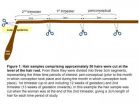(Press-News.org) After 17 years of groundbreaking 3-D images of rain and storms, the joint NASA and Japan Aerospace Exploration Agency Tropical Rainfall Measuring Mission (TRMM) will come to an end next year. NASA predicts that science operations will cease in or about April 2015, based on the most recent analysis by mission operations at NASA's Goddard Space Flight Center, Greenbelt, Maryland.
On July 8, 2014, pressure readings from the fuel tank indicated that TRMM was near the end of its fuel supply. As a result, NASA ceased station-keeping maneuvers that would keep the satellite at its operating altitude of 402 km (249.8 miles). Atmospheric drag is slowing TRMM, and it has begun its slow drift downward. Some fuel has been retained to conduct debris avoidance maneuvers to ensure the satellite remains safe during the drift down to re-entry, which is predicted to occur in the summer of 2015.
Originally launched in 1997 as a three-year mission, TRMM's extended mission life has provided a boon to the scientific understanding of precipitation and its role in broad weather patterns and climate. TRMM has allowed scientists to better understand how rain varies daily, seasonally and annually; how El Niño affects global rain patterns; how regional rain events like the Indian monsoon vary throughout the season; and even how humans have affected local precipitation through the effects of urban heat islands, deforestation and pollution.
"TRMM has been the world's foremost satellite for the study of precipitation and climate processes in the tropics, and an invaluable resource for tropical cyclone research and operations," says TRMM Project Scientist Scott Braun at NASA Goddard. "Data from TRMM will continue to foster science well after the mission ends, and, when combined with data from the new Global Precipitation Measurement Core Observatory (GPM), launched earlier this year by NASA's partner the Japan Aerospace Exploration Agency (JAXA), will contribute to a long-term precipitation climate record."
Orbiting at an angle to the equator that covers 35 degrees north to 35 degrees south of the equator, TRMM carries five instruments that collectively measure the intensity of rainfall, characteristics of the water vapor and clouds, and lightning associated with the rain events. One of the instruments, the Precipitation Radar, built by JAXA, is the first precipitation radar flown in space. It returns images of storms that for the first time have revealed close-up, 3-D views of how rain bands in tropical cyclones develop, potentially indicating how strong the storms might become.
Pulses of microwave radiation from the TRMM Precipitation Radar penetrate clouds to see raindrops and precipitation-sized ice such as hail. The radar's ability to make precise measurements of both the altitude and the intensity of precipitation gives scientists clues about the energy that fuels thunderstorms, hurricanes and other kinds of severe weather. The deepest and most intense thunderstorms have the potential to generate surface rainfall that may briefly exceed a rate of 100 millimeters (3.9 inches) per hour, and to generate hail, lightning and occasionally tornadoes.
Another key instrument is the TRMM Microwave Imager, or TMI, that provides images of rainfall across a swath more than three times as wide as that from the radar. Data from TMI go into forecasts of tropical cyclones made by the National Hurricane Center, and maps used by emergency managers that show areas at risk of flooding after heavy rains.
Because of how the Precipitation Radar works, science data is collected within narrow altitude ranges near 400 km (248.5 miles) and 350 km (217.5 miles). JAXA, which manages the Precipitation Radar data, recently stopped distribution of the radar data when TRMM fell below 392.5 km (243.9 miles) altitude. Observations will resume when the satellite nears 350 km (217.5 miles), which is estimated to be in February or March of 2015, allowing the collection of one more month of data before science operations stop.
The TMI and Lightning Imaging Sensor, another of TRMM's instruments, will continue operating during the entire drift-down period, although TMI data will be affected. The angle at which TMI views Earth's surface will be changing as will the field of view. However, the science team expects data to continue to be useful for rain estimates, and tropical cyclone and flood monitoring and prediction.
After launch by JAXA on Feb. 28, 2014, the GPM Core Observatory began its prime mission on May 29, and will have more than a year of overlap with TRMM's data as the satellite descends. The Core Observatory continues and expands upon TRMM's capabilities, carrying an advanced GPM Microwave Imager and JAXA's Dual-frequency Precipitation Radar.
The GPM Core Observatory's area of coverage extends beyond TRMM's coverage of the tropics as GPM provides coverage from the Arctic Circle to the Antarctic Circle. While this means fewer observations of the tropics, it also means that GPM will be able to observe hurricanes, like Sandy in 2012, that travel north (or south) farther into the mid-latitudes. GPM data is already in use to monitor tropical cyclones around the world by the Naval Research Laboratory. GPM will also be able to detect light rain and snowfall, a major source of available fresh water in some regions. The joint NASA-JAXA mission will study rain and snow around the world, joining with an international network of partner satellites to provide global precipitation datasets on half hourly and longer time scales.
INFORMATION:
An active region on the sun – an area of intense and complex magnetic fields – rotated into view on Oct. 18, 2014. Labeled AR 12192, it soon grew into the largest such region in 24 years, and fired off 10 sizable solar flares as it traversed across the face of the sun. The region was so large it could be seen without a telescope for those looking at the sun with eclipse glasses, as many did during a partial eclipse of the sun on Oct. 23.
"Despite all the flares, this region did not produce any significant coronal mass ejections," said Alex Young a solar scientist ...
AUSTIN, Texas— A new analysis of geologic history may help solve the riddle of the "Cambrian explosion," the rapid diversification of animal life in the fossil record 530 million years ago that has puzzled scientists since the time of Charles Darwin.
A paper by Ian Dalziel of The University of Texas at Austin's Jackson School of Geosciences, published in the November issue of Geology, a journal of the Geological Society of America, suggests a major tectonic event may have triggered the rise in sea level and other environmental changes that accompanied the apparent ...
Rachel MacTavish is growing salt marsh plants in microcosms that replicate the tide. She assembled them in an outdoor greenhouse at the Sapelo Island National Estuarine Research Reserve in Georgia, USA, with buckets from a hardware store, aquarium tubing, and pumps. Her tidal simulation units could be an important tool for preserving and restoring environmentally important wetlands, because they enable researchers to investigate tidal marsh plant growth in a controlled setting.
"Tidal wetlands are often influenced by many factors, and controlled experiments allow researchers ...
INDIANAPOLIS -- People with muscular dystrophy could one day assess the effectiveness of their medication with the help of a smartphone-linked device, a new study in mice suggests. The study used a new method to process ultrasound imaging information that could lead to hand-held instruments that provide fast, convenient medical information.
In the study presented Oct. 30 at the Acoustical Society of America's annual meeting, researchers determined how well muscles damaged by muscular dystrophy responded to a drug in mice with an animal form of the disease. They did so ...
WASHINGTON — New research points to tau, not amyloid-beta (Abeta) plaque, as the seminal event that spurs neuron death in disorders such as Alzheimer's disease. The finding, which dramatically alters the prevailing theory of Alzheimer's development, also explains why some people with plaque build-up in their brains don't have dementia.
The study is published online today in the journal Molecular Neurodegeneration.
Neuronal death happens when tau, found inside neurons, fails to function. Tau's role is to provide a structure — like a train track —inside ...
Contrary to popular belief, use of the supplement resveratrol (RSV) may not actually enhance the effects of high-intensity interval training (HIIT).
Many news outlets and health blogs have long recommended RSV as a complement to exercise and to enhance performance. However, results from a study by Queen's researcher Brendon Gurd suggest that RSV may actually impede the body's response to training.
"The easiest way to experience the benefits of physical activity is to be physically active," says Dr. Gurd, a professor in the School of Kinesiology and Health Studies. "The ...
Where does HIV hide? Antiretroviral drugs can usually control the virus, but can't completely eliminate it. So any strategy to eradicate HIV from the body has to take into account not only the main group of immune cells the virus targets, called CD4 or helper T cells, but other infected cells as well.
New research from Yerkes National Primate Research Center, Emory University, sheds light on the question of which cells support viral replication and persistence, and the answers have implications for future efforts to eliminate HIV from the body in human patients.
The ...
The pathogen Giardia duodenalis is present in mussels from freshwater run-off sites and from areas where California Sea Lions lounge along the coast of California, according to a team of researchers from the University of California, Davis. One of the G. duodenalis strains found is known to infect humans; the two others occur mostly in dogs and other canids. "Thus, the detection of these assemblages implies a potential public health risk if consuming fecally contaminated water or uncooked shellfish," says coauthor Woutrina Smith. The research is published ahead of print ...
Today the leading journal PLOS ONE published research that provides underlying scientific support for a fundamentally new type of natural alternative to the use of antibiotics in livestock feeds for growth promotion and disease prevention. The paper is the result of work by both independent and company scientists. Avivagen Inc. is a wellness company developing and delivering products that support and enhance the health and quality of life for animals and the people who care for them.
The discovery that the product formed by full, spontaneous oxidation of beta-carotene, ...
Drug tests on 517 mothers in English inner city hospitals found that nearly 15% had taken recreational drugs during pregnancy and that mothers of babies with birth defects of the brain were significantly more likely to have taken drugs than mothers with normal babies. The study found no significant links between recreational drug use and any other type of birth defect.
The study was led by a team of UCL researchers co-ordinating data collection from hospitals across London, Bristol and Birmingham and the results are published in the journal PLOS ONE. The study included ...



